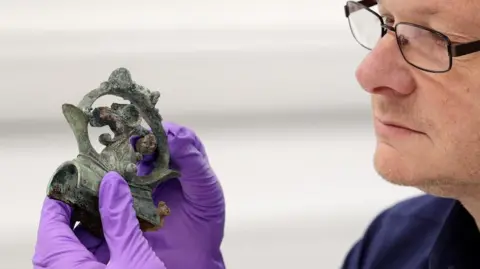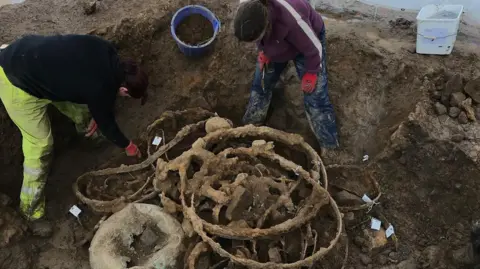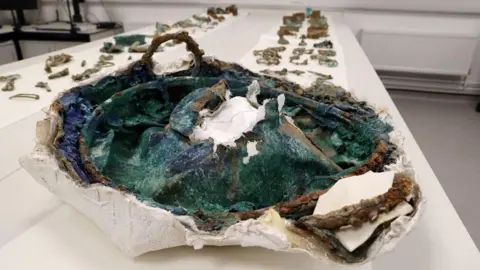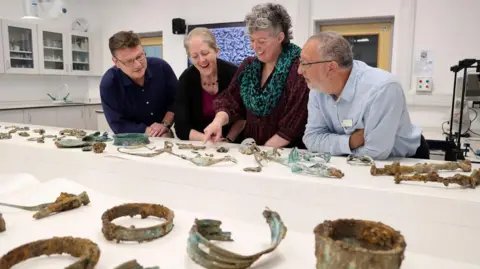Non -like ‘Melsonby Iron Age Stack

BBC News, Yorkshire
 Durham University
Durham UniversityArchaeologists helped the emergence of one of the “largest and most important” iron age findings in the UK.
Melsonby Hoard was discovered by the metal detector Peter Heads in an area near Yorkshire, Melsonby and dug with the help of Durham University.
It contains more than 800 products, including two boilers or ships, horse cable bundles, reinstate lice, ceremony spear and 28 iron tires, which are believed to have been buried about 2,000 years ago.
Historians believe that finding “unprecedented” can lead to a “re -evaluation” of the wealth and status of the elite of the elite living in Northern England at the time.
 Durham University
Durham UniversityAfter the first discovery was notified to the authorities in December 2021, the site was excavated in 2022 with the support of British Museum and a grant from the History of £ 120,000 from England.
Early analysis of the stack on Tuesday shows that many items were deliberately burned or broken before they were buried as a show of power and delegation.
Tom Moore, Head of the Archeology Department of Durham University, said the size and scale of the finding was “extraordinary for England and probably for Europe.”
He said that the stack showed that there was more reserves in the north of England than before.
“It was probably part of a network of elites in the UK, Europe and even the Roman world, which had the material in this resignation.” He said.
“The destruction of many high -statitic objects seen in this stack shows that the iron age is rarely seen in the UK and the elite of North England is as strong as the southern colleagues.”
Although no human remains are found, it is thought that objects may be burned in a funeral pirate before they are buried.
 Durham University
Durham UniversityAnalysis: Danny Savage, BBC News
There is a real buzz in the archeology laboratories at the University of Durham about the opening of Melsonby Hoard. Curators think this is a lifetime discovery.
Hundreds of recovered works have spread to a climate -controlled room on long tables.
You should use your imagination a little, the iron age works 2,000 years ago are rusted or faded and away from the original splendor. Some were decorated with coral bleached for centuries.
But the story they say is extraordinary.
Iron Age experts now have evidence that people are now four -wheel wagons and two -wheeled warfare.
Now Northern England’s Iron Age residents have evidence that they have trade connections with the continent and the growing Roman Empire.
This will engage in experts for years.
There is also some privacy. The exact place of the discovery does not emerge on the concern that the bandit treasure hunters will emerge at night and will begin to look for other works.
History is valuable – in different ways for different people.
 Durham University
Durham UniversityAmong the substances, some of them were partial residues of seven four -wheeled wagons and/or two -wheeled warfare, including detailed harness sets for at least 14 Lesbos decorated with red, Mediterranean coral and colored glass.
In addition, three ceremonies, which were decorated with both Mediterranean and iron age styles and probably used as a wine mixing container, found three -fancy boilers or ships.
Some of the objects found were the most closely related to others in the continental Europe, which shows that people share technologies in this distance.
Objects have been defined using screening technology at the University of Southampton, which helped archaeologists understand how to dig objects without causing damage.
“This is one of the most important and exciting iron age discoveries in England.
He continued: “The iron age in North and England takes a new shed light on life, but also shows connections with Europe.”
 Durham University
Durham UniversityThe Yorkshire Museum launched a donation collection campaign to secure his stack for his collections.
“This iron age is an unprecedented finding in the North, which will help us understand more about this remarkable period in our history.
“We have an exciting opportunity to save the stack for the people of Ulus and Yorkshire.
“We can make it more accessible to everyone, and we can learn more about this fascinating period, why the stack is buried, how objects may have been used and that may belong.”
A number of objects from the stack will be exhibited at the Yorkshire Museum between 25 March 2025.
Listen to the emphasis North Yorkshire in BBC soundsCatch the last Section of Look North.






